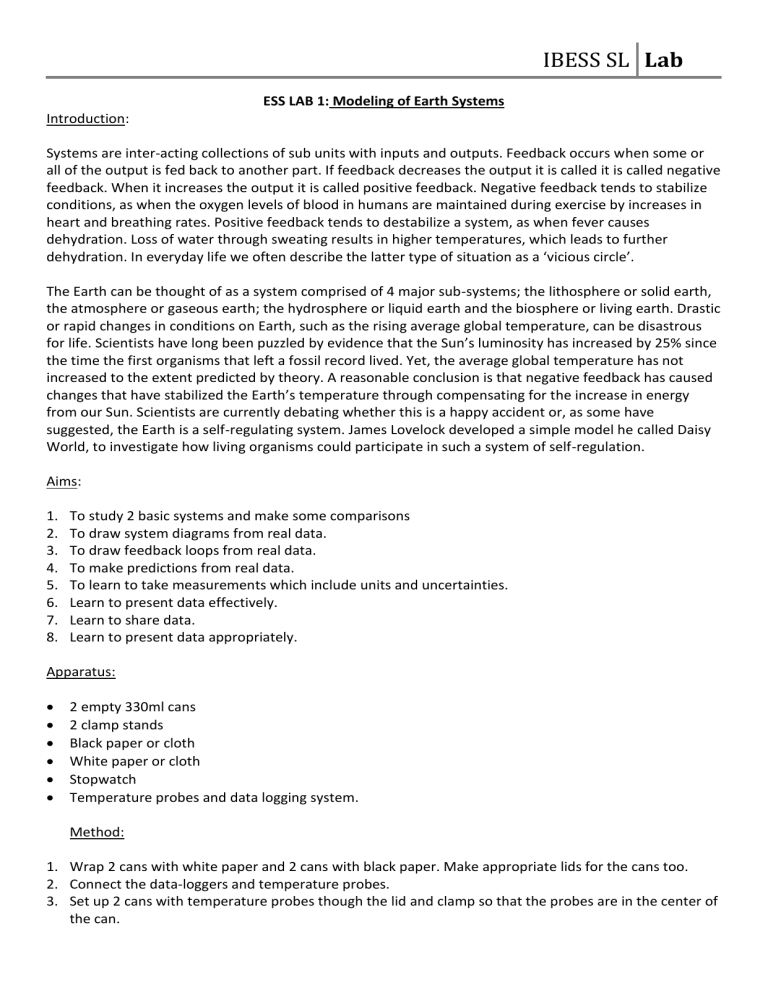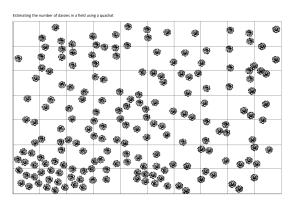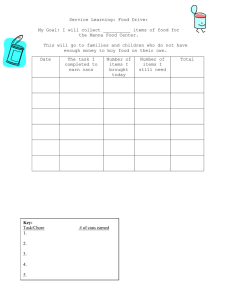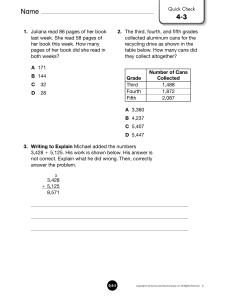
IBESS SL Lab ESS LAB 1: Modeling of Earth Systems Introduction: Systems are inter-acting collections of sub units with inputs and outputs. Feedback occurs when some or all of the output is fed back to another part. If feedback decreases the output it is called it is called negative feedback. When it increases the output it is called positive feedback. Negative feedback tends to stabilize conditions, as when the oxygen levels of blood in humans are maintained during exercise by increases in heart and breathing rates. Positive feedback tends to destabilize a system, as when fever causes dehydration. Loss of water through sweating results in higher temperatures, which leads to further dehydration. In everyday life we often describe the latter type of situation as a ‘vicious circle’. The Earth can be thought of as a system comprised of 4 major sub-systems; the lithosphere or solid earth, the atmosphere or gaseous earth; the hydrosphere or liquid earth and the biosphere or living earth. Drastic or rapid changes in conditions on Earth, such as the rising average global temperature, can be disastrous for life. Scientists have long been puzzled by evidence that the Sun’s luminosity has increased by 25% since the time the first organisms that left a fossil record lived. Yet, the average global temperature has not increased to the extent predicted by theory. A reasonable conclusion is that negative feedback has caused changes that have stabilized the Earth’s temperature through compensating for the increase in energy from our Sun. Scientists are currently debating whether this is a happy accident or, as some have suggested, the Earth is a self-regulating system. James Lovelock developed a simple model he called Daisy World, to investigate how living organisms could participate in such a system of self-regulation. Aims: 1. 2. 3. 4. 5. 6. 7. 8. To study 2 basic systems and make some comparisons To draw system diagrams from real data. To draw feedback loops from real data. To make predictions from real data. To learn to take measurements which include units and uncertainties. Learn to present data effectively. Learn to share data. Learn to present data appropriately. Apparatus: 2 empty 330ml cans 2 clamp stands Black paper or cloth White paper or cloth Stopwatch Temperature probes and data logging system. Method: 1. Wrap 2 cans with white paper and 2 cans with black paper. Make appropriate lids for the cans too. 2. Connect the data-loggers and temperature probes. 3. Set up 2 cans with temperature probes though the lid and clamp so that the probes are in the center of the can. IBESS SL Lab 4. Take the initial temperature, start the stopwatch and record the temperature every 5 minutes for the length of your lesson. While you are collecting data, write a suitable focused research question for this experiment. Identify the independent; dependent; and controlled variables. Offer a hypothesis with a scientific explanation. Results, analysis and conclusion: Make a suitable table in which to record your RAW data. Record your results into this table as you take them. Do not copy it up, or copy from your friends. Plot your results on a single graph and write a sentence to explain what your graph is showing you. Draw 2 systems diagrams, 1 for each can. Try to show the flows quantitatively to aid explanation of your results. Discussion and evaluation: The Daisy World Parameters: 1. The atmosphere is clear and water covers the entire surface. 2. Water is a reflective surface. 3. There are 2 species of plants growing on the surface. These daisies can exist between temperatures of 5oC and 40oC. 4. One species is light coloured, the other is dark coloured. 5. The dark species grows best in cool conditions with maximum growth occurring at 22.5oC. 6. The light species grows better under warmer conditions. 7. There are no other living organisms. Based on (some of) the parameters above, make a suitable conclusion explaining your results, and how they allow you to make some predictions about Daisy World. Can you draw labeled negative feedback loops to show; i) what happens if too many black daisies start to cover the surface and ii) what happens if too many white daisies start to cover the surface. Make a labeled sketch graph to illustrate these feedback loops. Place temperature on the x-axis and number of daisies on the y-axis. This is a very basic model of a simple system. In what ways is it realistic? And in what ways do you consider it to unrealistic? Bibliography Lovelock, James. Healing Gaia. 1st American ed. New York: Harmony Books, 1991. pp 66- 72





